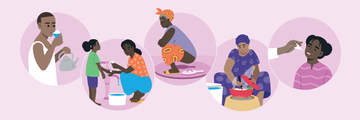Share key facts about cholera with the community 💡
Transmission:
- Cholera is transmitted by ingestion of water or food contaminated with faeces/poop.
- Water or food can be contaminated by people or animals through faeces directly or indirectly by unwashed hands or food washed/prepared with contaminated water.
- Cholera can also be transmitted through contact with body fluids of a person contaminated with cholera, including after death.
Most vulnerable to severe symptoms:
- Children under five years old.
- Malnourished people, especially children.
- Pregnant women.
- People who do not have easy access to rehydration therapy and health services.
- People with weakened immune system.
Most vulnerable to contracting the disease:
- People living in areas that have poor water, sanitation and hygiene facilities and services.
- People on the move with poor access to water, sanitation and hygiene facilities and services.
Symptoms:
People show symptoms with different levels of severity. Some become very sick. Most people develop mild symptoms, while serious cases develop acute watery diarrhoea with severe dehydration. Some people do not show any symptoms, but they can still transmit the disease. This is why prevention and control are so important.
Symptoms to look out for are:
- Watery diarrhoea (looking like rice water, often without smell)
- Vomiting, even if it is occasionally.
- The presence of abdominal cramps.
- Dehydration, sudden if you or a loved one feel thirsty suddenly.
- Confusion, unconsciousness and seizures.
Remember that not everyone infected with the bacteria becomes sick, although the bacteria are present in their faeces. Approximately 20% of people infected with the bacteria show symptoms

Average Rating: ☆ ☆ ☆ ☆ ☆ (0 reviews)

